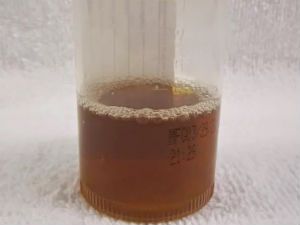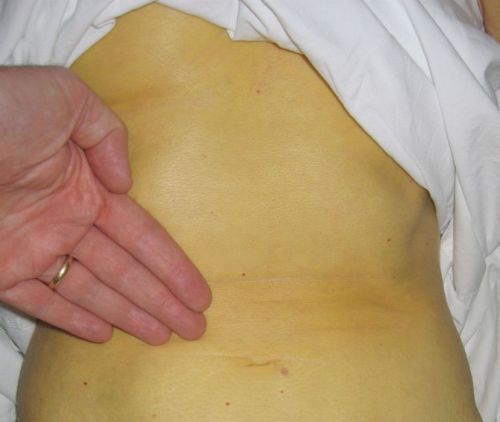Urine from a healthy person has a straw yellow hue. Discoloration can be due to both physiological and pathological factors. Brown urine, with the exclusion of natural causes, indicates various diseases not only kidney but also other organs.
Mechanisms of development
The urine may change its color depending on the ratio of water and dense component (salts, cellular elements), as well as the availability of coloring substances that are released in normal (urochrome), and pathology (bilirubin, hematoporphyrin).
Physiological causes of staining of urine in brown color:
- the presence in the diet of beans, peas, soybeans, blackberries, rhubarb, strong black tea in large quantities;
- the use of drugs (activated charcoal, antibacterial agents (rifampicin, metronidazole, phenyl salicylate, salol), laxatives containing Senna);
- pronounced dehydration due to sweating, effects of heat, intense physical activity, lack of drinking.

When restoring the normal mode of drinking cessation medication, excretion of the coloring of the food product from the body the urine color returns to normal. If not, it is advisable to conduct laboratory research, and to make test results to the doctor.
Pathological causes of brown urine allocation:
- jaundice in diseases of the liver (parenchymal), galeotto obstruction (obstructive), the breakdown of red blood cells (hemolytic);
- fluid loss during diarrhea or vomiting, infectious processes, burns;
- inflammatory diseases of the kidneys, accompanied by congestion, difficulty urination;
- diseases of disturbed metabolism, increased release of iron (hemochromatosis), increased number of pigments in tissues and body fluids (porphyria);
- poisoning with copper compounds;
- the pathology of the sexual sphere in men and women.

Color change is possible at any age. In addition to the reasons described, the brown urine in a child with probable genetically caused diseases (tyrosinemia I-III types). The infants may experience neonatal jaundice, which also darkens the urine. Therefore, children must be consulted by a pediatrician, a children’s nephrologist, gastroenterologist.
Jaundice of different origin, a change in the color of urine from light brown to dark brown shade
Scale coloration of the urine has a wide range. So, an intensive dark brown color urine becomes with the development of hemolytic anemia, which also darkens the stool, and the skin turns lemon-yellow. Color of dark beer (dark brown urine) is also observed in parenchymatous jaundice, often with hepatitis, inflammation of the liver tissue under the influence of viruses. Obstructive jaundice is accompanied by the secretion of very dark urine with a hint of green, complete discoloration of feces.
Red-brown (type of meat slops) is characteristic of diseases of the kidneys (glomerulonephritis) due to allocating a large amount of modified erythrocytes. Dark yellow brown shade characteristic of inflammatory diseases of the urinary system (pyelonephritis, pielity), accompanied by a purulent discharge (a whitish clots or flakes, drop down into the sediment).
Features depending on gender
In inflammatory diseases of the prostate, appendages of testicles, VAS deferens through the urethra into the urinary tract gets altered in the prostate secretion, seminal fluid, causing the selection of men brown urine. Stagnation characteristic of prostatitis (prostate inflammation), penetration of erythrocytes from blood vessels in the urethra. As a result, it is also possible darkening, the appearance of rust (reddish) tint.
Staining changes and traumatic damage to the scrotum when there is brown-red color. The appearance of urine is brown the man on the background of a recent injury, pain in testicles, difficulty in urination, an urgent need to seek medical help from a doctor, surgeon, urologist.
Women have dark urine may be due to gynecological diseases of inflammatory and noninflammatory nature.

Most important reasons:
- venereal disease;
- malignant diseases of the uterus (tumor destruction of the body or neck);
- fibroids of significant size with a pronounced hyperemia, release of red blood cells, first in sex, later – in the urinary tract.
The disintegration of the tumor is accompanied not only by changing the color of the urine from women, but also the appearance of the characteristic fetid smell, the General symptoms (weight loss, loss of appetite, recurrent fever, vaginal discharge dirty brown, reddish color with a unpleasant smell).
When examining the patient it is necessary to consider the possibility of defeat the sexual sphere, to refer to consultation: men to a urologist and women to gynecologist.
During pregnancy dark urine may be the cause of early toxicity. In severe cases, there is the smell of acetone. During pregnancy increases the load on the liver, possibly an increased release of bilirubin, which also leads to the emergence of brown. Gestational pyelonephritis develop often develop in the second or third trimester, is accompanied not only by change in the color of urine, but also other changes of an inflammatory nature.
Early toxemia of pregnancy is manifested by frequent vomiting, leading to dehydration, a dramatic concentration of secreted fluid and dark urine
The indications for urgent medical advice
If the changes in urine color is accompanied by a number of symptoms pointing to a lesion of the internal organs or saved for no apparent reason several days, then you need to go to the doctor.
In inflammatory diseases of the urinary and reproductive systems not only excels urine brown, but observed the General and local signs of inflammation.
The greatest diagnostic importance:
- fever (body temperature above 37.5°C, in the presence of pus – sharp rises to 39-40°C);
- discomfort or pain in the lower back (either side or bilateral);
- frequent urination (small amounts);
- pain during urination, cramps in the region of the urethra, perineum;
- weakness, reduced efficiency, disturbance of appetite, sleep, headaches;
- possible fluctuations in blood pressure.
Dark urine due to high discharge of substances involved in the metabolism of hemoglobin and bilirubin occurring in liver, accompanied, as a rule, yellowing of the skin, mucous membranes, discoloration of feces, common clinical manifestations.

Most dangerous:
- jaundice on the background of earlier high temperature, darkening of the stool, is characteristic of hepatitis, cholangitis (inflammation of bile ducts);
- jaundice, itchy skin, darkening of the faeces (characteristic of cirrhotic liver, which means replacement of non-functioning liver cells by connective tissue);
- yellowing of skin, sclera without prior state changes, discoloration of feces (inherent to tumors of the pancreas, bile ducts).
The presence in the urine of mucus, blood, purulent discharge, abnormal smell are mandatory for research in the laboratory and medical examination.
In the laboratory examines not only the color, transparency, specific gravity, pH of urine, but urinary sediment
If the patient has brown urine color, it is important to rule out any physical causes. To restore, if necessary, water balance, reduce the amount of food, affecting its color. At the end of the reception dyeing medicinal substances color is restored, in this case special treatment is required. If you have other symptoms you need to seek medical advice. The doctor, after examination, finds out why the change in coloration of urine, appoints further studies confirm the diagnosis, prescribes treatment if necessary.
Timely access to a physician provides the diagnosis of the causes of discoloration of urine and adequate treatment, which in turn helps to prevent complications of the disease.




Very interesting points you have remarked, appreciate it for putting up.